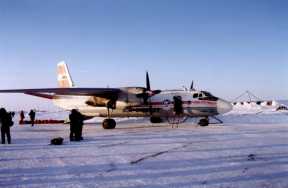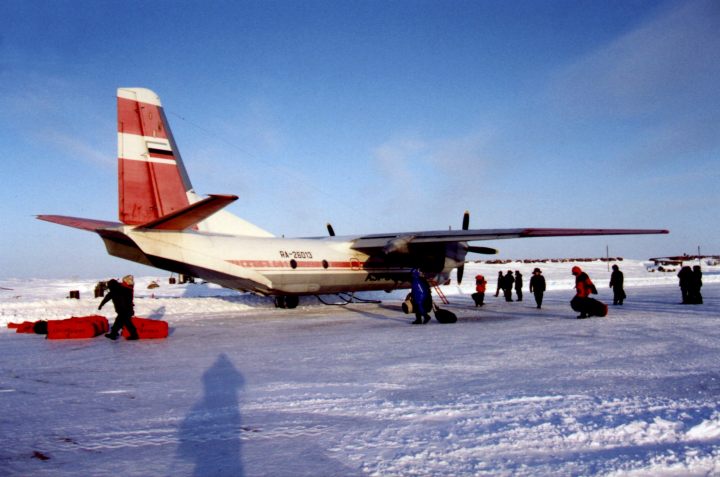|
This is
the Russian
Antonov An-26 Curl Transport Cargo plane.
We had this Russian An-26 Curl plane super loaded with
equipment and people and fuel. Almost the entire was filled with a huge
white plastic fuel tank. We had to stuff our equipment anywhere and
everywhere. I couldn't believe that this plane could take off with this
much weight. Only some of our members had a seat to sit in. Really, the
seats were just cloth benches along the sides and in front of the internal fuel
tank. The smell of jet fuel was very strong, yet the Russian crew never
hesitated to smoke.
The cold temperatures of operation gave the engines, wings
and propellers an increased efficiency making our overall weight to be a less of
a problem.
When I was outside of the airplane I noticed that all of the
tires were tremendously weather checked, but the tread did not appear worn out.
I told some other people that this plane would not be allowed to fly in the
United States. But the truth is that the weather checking of the tires
came from the extreme cold temperatures of operation. One of my friends
that worked at O'Hare Airport in Chicago said that in the extreme cold, the big
jet aircraft would also have weather checking.
One other thing. When we were preparing to take off
from Barneo Base on the Geographic North Pole, I looked down at the brake line
just as the same time that one of the crew members saw the line also. The
brake line was completely broken off of its mounting nipple. The crew
member just reached down and pushed it back on the nipple. It was going to
come off as soon as the pilot hit the brakes, but what else can he do, there was
no service hanger on the Geographic North Pole.
There was one thing that I didn't understand. The
crewmember was off loading fuel to compensate for our excess weight and the
broken, shortened runway. The crewmember would drain the fuel into 55
gallon drums and then look at the pilot. The pilot would shake his head
and he had to continue off loading the fuel. I am wondering what the pilot
was looking at to know the weight of the aircraft. We did not measure the
weight of the equipment on the plane, we just stuffed the fuselage full.
When we took off of the all ice runway, the pilot pulled the
nose up as far as he could as if he was doing a soft field takeoff.
It's interesting, because we were not on a soft field, it was solid ice with no
snow and a lot of traction. I'm a pilot and I'm surprised that he used
this method for takeoff.
- Crew: 4 (2 pilots, 1 engineer, 1 navigator
- Capacity: 40 passengers
- Payload: 5,500 kg (12,000 lb)
- Length: 23.8 m (78 ft 1 in)
- Wingspan: 29.2 m (95 ft 9 in)
- Height: 8.32 m (27 ft 3 in)
- Wing area: 74.98 m (ft)
- Empty weight: 15,020 kg (33,110 lb)
- Useful load: 4,500 kg (9,900 lb)
- Max takeoff weight: 24,000 kg (53,000 lb)
- Powerplant: 2 Progress AI-24VT turboprops, 2,820 shp
(2,100 kW
- Cruise speed: 440 km/h (240 knots, 275 mph)
- Range: 2,550 km (with maximum fuel; 900 to 1100 km
with maximum payload) (1,380 nm, 1,580 mi, 485 nm, 595 nm)
- Service ceiling: 7500 m (17,000 ft)
Y-7H is the Chinese production version.
The An-26 Curl is a highly flexible aircraft designed for short hauling.
It is a short to medium range military and commercial transport and cargo
carrier. It is equipped with side benches to accommodate troops or skydivers.
Thanks to the rear loading ramp, the An-26 can operated without much ground
support. The Tactical transport, development of the An-24. The An-26 like the
An-24RV has an auxiliary turbojet in the right engine nacelle, used for
high-and-hot operations.
The
Trip Continues. Come with us next year.
|


